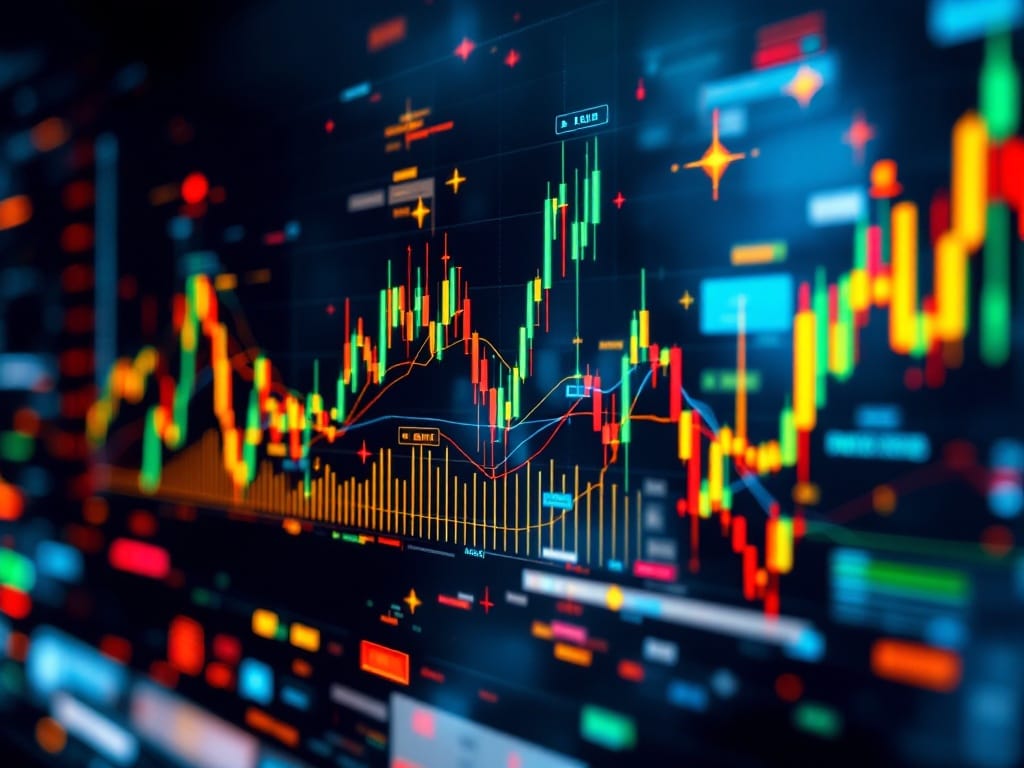Guide to Futures Algorithms: Do They Work?

What Are Futures Algorithms?
Futures algorithms are like your favorite playlist on shuffle—set it once, and let it handle the rest. In trading, futures algorithms (or "algo trading futures" as the cool kids say) are pre-programmed systems designed to execute trades based on specific criteria like price, volume, or timing. They operate at lightning speed, making them perfect for the fast-paced world of futures trading.
Gone are the days of squinting at multiple screens and manually placing orders. With futures automated trading, traders can now rely on sophisticated systems to make decisions in milliseconds. But how did we get here? Let’s dive into the timeline of trading evolution.
The Evolution of Trading: From Manual to Automated
Not too long ago, trading floors were filled with loud voices, frantic hand signals, and paper flying everywhere. Manual trading required sharp instincts, human analysis, and, let’s be honest, a bit of caffeine-fueled chaos. But as technology advanced, automated futures trading systems emerged, and everything changed.
From the early adoption of simple Excel macros to today’s AI-powered futures trading algorithms, automation has revolutionized trading. These systems now analyze complex data sets, execute trades, and adapt to market conditions faster than any human could.

Why Futures Algorithms Are a Game-Changer
Futures trading is all about speed, precision, and taking the emotion out of the equation. Enter futures algorithmic trading strategies, your new best friend in the trading world.
Speed and Efficiency in Trading
Imagine having a superpower that allows you to react to market changes in microseconds. That’s the magic of automated futures trading systems. Algorithms can process massive amounts of data, identify patterns, and execute trades faster than you can say "buy low, sell high." This speed often translates into better trade execution and higher potential profits.
Removing Emotional Decisions in Trading
Let’s admit it—humans can be a little emotional, especially when money is on the line. Fear, greed, or even overconfidence can cloud judgment and lead to poor decisions. Futures automated trading eliminates this issue by sticking to pre-programmed rules. It’s like having a level-headed trading partner who never panics.
Understanding Different Types of Futures Algorithms
Not all futures algorithms are created equal. They come in different flavors, each suited to specific trading styles and goals.
Automated Futures Trading Strategies
Want to trade like a pro while sipping your morning coffee? Automated futures trading strategies handle it all. From trend-following to mean reversion, these strategies are designed for a variety of market conditions. For example, trend-following algorithms identify when prices are moving in a consistent direction, while arbitrage strategies capitalize on price discrepancies.
Futures Algorithmic Trading Systems
A futures algorithmic trading system is the complete package—software, hardware, and execution protocols all working together. Think of it as a trading command center, designed to handle everything from analytics to order placement. These systems are essential for algo futures traders who want to stay competitive.

How Do Futures Algorithms Work?
Here’s where things get geeky—in the best way possible. Let’s break down the mechanics of these high-tech trading tools.
Think of futures automated trading systems like a super-smart robot that follows a specific set of rules to buy and sell futures contracts - it's similar to having a chess computer that thinks several moves ahead. These futures trading algorithms are like having a tireless assistant that watches hundreds of markets at once, looking for special patterns that signal good times to trade, much like how a weather app collects data to predict tomorrow's forecast. The best automated futures trading software uses math and special rules to make decisions faster than any human could, just like how video games use computer code to control enemy characters. Futures auto trading systems work around the clock without getting tired or making emotional decisions, similar to how a self-driving car uses sensors and computers to navigate safely. Finally, these automated futures trading systems have built-in safety features that protect your money, like having guardrails on a mountain road that keep cars from going over the edge.
The Mechanics of Futures Algo Trading
At its core, futures algo trading operates based on a set of rules. These rules might include conditions like "buy when the price drops 2% in 5 minutes" or "sell if the volume spikes 3x." The algorithm continuously scans the market, waiting for these conditions to be met before executing trades.
How Algorithms React to Market Changes
The adaptability of futures trading systems is what makes them so powerful. Algorithms can react to market changes in real-time, adjusting strategies based on emerging trends or unexpected volatility. This makes them invaluable in dynamic markets.
Monitoring and Adjusting Algorithms for Optimal Performance
Even the best automated futures trading bot needs a bit of babysitting. Regular monitoring ensures that the algorithm is performing as expected. Traders can tweak settings, refine strategies, or update parameters to stay ahead of the curve.
Do Futures Trading Algorithms Really Work?
The million-dollar question: are they worth it? Let’s weigh the pros and cons.
Futures automated trading systems really do work, but they're kind of like having a really smart calculator - they're only as good as the instructions we give them. Automated futures trading strategies can be super successful because they can watch the markets 24/7 without getting tired or making emotional decisions, similar to how a robot vacuum cleaner keeps working even when you're sleeping.
However, just like any tool, futures trading algorithms need to be carefully programmed and monitored - think of it like setting up dominos; if one piece is out of place, the whole thing might not work as planned. The most successful algo futures traders understand that these systems aren't magic money machines, but rather tools that need regular updates and adjustments, like how a car needs regular maintenance to run properly.
Pros of Automated Futures Trading Bots
- Speed: Algorithms execute trades in milliseconds.
- Consistency: They stick to the plan, no matter what.
- Scalability: Trade multiple markets simultaneously.
Cons of Automated Futures Trading Bots
- Cost: High-quality futures automated trading systems aren’t cheap.
- Complexity: Setup and maintenance require technical know-how.
- Over-optimization: Algorithms can sometimes perform well in backtests but fail in live trading.
How to Set Up Your Futures Algorithmic Trading
Ready to dive in? Here’s how to set up your own automated futures trading system.
Choosing Automated Futures Trading Software
The first step is finding the best automated futures trading software. Look for platforms that offer robust analytics, customization options, and seamless integration with your broker.
Developing Futures Algorithmic Trading Strategies
Once you’ve chosen your software, it’s time to build your strategy. Whether you’re focusing on trend-following or arbitrage, make sure your approach aligns with your trading goals.
Common Pitfalls and How to Avoid Them
Even experienced algo futures traders make mistakes. Here’s how to avoid common pitfalls.
Think of automated futures trading systems like a robot chef - even with the best recipe, things can still go wrong if you're not careful. One of the biggest mistakes traders make with futures trading algorithms is expecting them to work perfectly without any supervision, which is like leaving your oven on without checking your food - it could lead to disaster. Another common problem with futures auto trading systems is over-optimizing your strategy using old data, similar to how studying only last year's test questions won't help you with this year's different exam questions. Many beginners using automated futures trading software fall into the trap of risking too much money too quickly, which is like jumping into the deep end of a pool before learning to swim properly. The best automated futures trading strategies need regular updates and monitoring, just like how a car needs tune-ups to keep running smoothly, and skipping this maintenance is a recipe for trouble. Finally, some traders forget to include proper safety measures in their futures algorithmic trading strategies, such as stop-losses and position sizing rules - that's like riding a bike without a helmet or knee pads.
Challenges of Futures Algorithmic Trading
From sudden market crashes to software glitches, challenges are inevitable. Be prepared for the unexpected and always have a backup plan.
How to Avoid Common Obstacles in Automated Futures Trading
Test your algorithm extensively before going live, and don’t ignore data quality. Garbage in equals garbage out, even for the best futures auto trading systems.
The Future of Futures Algorithms
What’s next for the world of automated futures trading? Let’s explore.
Emerging Trends in Automated Futures Trading Systems
AI and machine learning are set to take futures automated trading systems to the next level. Expect smarter algorithms that can learn and adapt over time.
Predictions for Futures Automated Trading Systems
As technology evolves, futures algorithmic trading will become more accessible, allowing even retail traders to compete with institutional players.
Are Futures Algorithms Worth It?
If you’re looking for speed, efficiency, and less stress, futures trading algorithms are worth considering. They aren’t perfect, but with the right setup and strategy, they can be a game-changer.
FAQs About Futures Algorithms
What exactly are futures algorithms?
These are pre-programmed systems that execute trades based on specific criteria like price, volume, or timing. Futures algorithms (or futures automated trading systems) are like having a super-smart digital assistant that trades for you using specific rules and instructions.
How can beginners get started with futures algorithm trading?
Start with simple strategies, use demo accounts, and gradually scale up as you gain confidence.
What are the main benefits of using automated futures trading strategies?
They offer speed, consistency, and the ability to trade multiple markets simultaneously.
Are there any risks associated with futures automated trading?
Yes, including software glitches, market volatility, and over-optimization.
How do I choose the best automated futures trading system?
Look for platforms with robust features, user-friendly interfaces, and strong customer support.
FAQs About Funded Futures Network
What types of futures trading programs does Funded Futures Network offer?
FFN offers funded trading programs where traders can access accounts up to $250,000 after passing an evaluation.
What are the minimum deposit requirements to start trading with Funded Futures Network?
There are no minimum deposits; traders only pay for the evaluation program. This subscription is on a month to month basis. Once you pass the evaluation you get to trade with the firms capital instead of risking your own.
What platforms does Funded Futures Network offer for trading?
FFN supports popular platforms, you can use any platform that will connect to Rithmic. You can also use one of the platforms that come with any FFN account. FFN comes with EdgeproX and Quantower, you can use one of the two.
Are there options for paper trading or simulated trading on Funded Futures Network?
When you sign up for FFN, you can use the simulated trading feature on either platform provided. This allows you to trade Futures and test strategies without wrecking your evaluation.
How can clients benefit from using the Funded Futures Network platform?
FFN offers a supportive community, educational resources, and a path to trade with zero personal risk. They also provide live data and trading platforms so you can trade futures. Once you get funded with FFN, you can withdraw real profits.



